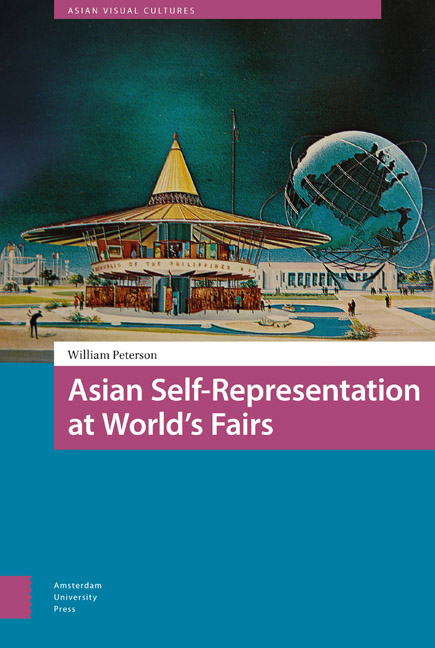Book contents
- Frontmatter
- Dedication
- Contents
- List of Figures
- Acknowledgements
- Note on Works Cited
- Note on Asian Names
- 1 Introduction: Setting the Stage
- 2 The Master of the Form: Japan at San Francisco's 1915 Panama-Pacific International Exposition
- 3 The New China and Chinese-Americanness: China at San Francisco's 1915 Panama-Pacific International Exposition
- 4 Performing Japan in the ‘World of Tomorrow’: Japan at the 1939-1940 New York World's Fair
- 5 From ‘Panda Diplomacy’ to Acrobat Diplomacy: China at the Brisbane's Expo ‘88
- 6 Fashion, Dance, and Representing the Filipina: The Philippines at the 1964-1965 New York World's Fair
- 7 Performing Modernity under Sukarno's ‘Roving Eye’: Indonesia at the 1964-1965 New York World's Fair
- 8 Maximizing Affect, Minimizing Impact with Hansik: South Korea at the 2015 Milan International Exposition
- 9 Hard and Soft Power in the Thai Pavilion: The Spectral Presence of King Bhumibol at the 2015 Milan Exposition
- 10 Conclusion: The Future of Asian Self-Representation at the International Exposition
- Works Cited
- Index
3 - The New China and Chinese-Americanness: China at San Francisco's 1915 Panama-Pacific International Exposition
Published online by Cambridge University Press: 21 November 2020
- Frontmatter
- Dedication
- Contents
- List of Figures
- Acknowledgements
- Note on Works Cited
- Note on Asian Names
- 1 Introduction: Setting the Stage
- 2 The Master of the Form: Japan at San Francisco's 1915 Panama-Pacific International Exposition
- 3 The New China and Chinese-Americanness: China at San Francisco's 1915 Panama-Pacific International Exposition
- 4 Performing Japan in the ‘World of Tomorrow’: Japan at the 1939-1940 New York World's Fair
- 5 From ‘Panda Diplomacy’ to Acrobat Diplomacy: China at the Brisbane's Expo ‘88
- 6 Fashion, Dance, and Representing the Filipina: The Philippines at the 1964-1965 New York World's Fair
- 7 Performing Modernity under Sukarno's ‘Roving Eye’: Indonesia at the 1964-1965 New York World's Fair
- 8 Maximizing Affect, Minimizing Impact with Hansik: South Korea at the 2015 Milan International Exposition
- 9 Hard and Soft Power in the Thai Pavilion: The Spectral Presence of King Bhumibol at the 2015 Milan Exposition
- 10 Conclusion: The Future of Asian Self-Representation at the International Exposition
- Works Cited
- Index
Summary
Abstract
Eager to shake off the trappings of the Manchu-dominated Qing Dynasty, the new government of the Republic of China sought to present an image of itself at the 1915 San Francisco exhibition as both inheritor of a long and proud civilization as well as a country embracing modernity. Complicating the situation was the San Francisco Bay area's large Chinese population, a group that in spite of their many years on American soil, was much maligned and stereotyped by the general population. China's government largely followed Japan's model, with a series of attractive pavilions in a garden compound, while the so-called “Chinese Village’ in the fair’s entertainment zone featured an exhibit that provoked much controversy.
Keywords: Chinese in California; Chinese trade
Emerging from the detritus of the Qing Dynasty (1644-1912), the new government of the Republic of China was internally divided as it began preparations to represent itself at the Panama Pacific International Exhibition (PPIE). At the time of the Chinese pavilion groundbreaking in October, the country was led by Provisional President Yuan Shikai, who briefly restored the monarchy by the end of the 1915, installing himself as Emperor, serving for only a few short months until his death the following year. As preparations were underway to present in San Francisco, China was already plunging in disarray following the assassination of the youthful Kuomintang President and Prime Ministerial hopeful Song Jiaoren on 22 March 1913, most likely at the behest of Yuan himself. Given the internal chaos increasingly overtaking China which would worsen after 1915, it is perhaps not surprising that Chinese self-representation was largely wrapped in the mantle of its long history of civilization while sidestepping unhappy recent memories of the inward-looking, decidedly anti-modern, Manchu rule. The longevity of China's traditions and the exquisiteness of its craftsmanship in porcelain and woodworking were on display in its national pavilions and the Palace of Fine Arts, while Chinese products were exhibited in the exposition’s themed ‘palaces,’ aimed at increasing American demand for imported Chinese goods. The other complicating factor was the Chinese community in the San Francisco Bay area, and particularly in the city's well-established Chinatown, which had much to gain or lose from the ways in which China was represented at the fair, largely because their position in America, like that of their mother country within an Asia increasingly dominated by Japan, was so precarious.
- Type
- Chapter
- Information
- Asian Self-Representation at World's Fairs , pp. 79 - 112Publisher: Amsterdam University PressPrint publication year: 2020

